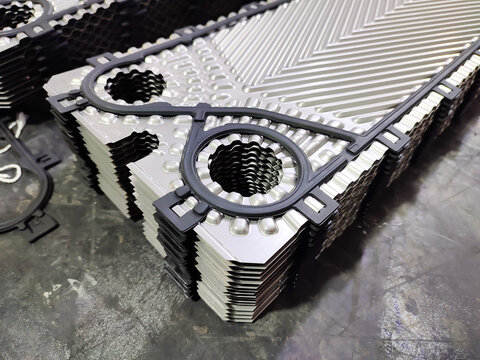Introduction
Heat exchanger plates are the backbone of plate heat exchangers, engineered to provide unparalleled heat transfer efficiency across a multitude of industrial and commercial applications. These plates are meticulously designed to enhance thermal performance by creating a large surface area within a compact structure, allowing efficient heat exchange between fluids with minimal energy losses. The intricate patterns embossed on the plates promote turbulence, optimizing heat transfer while reducing fouling and scaling.
In recent years, technological advancements have elevated the performance of heat exchanger plates. Innovations in materials, such as corrosion-resistant alloys and antifouling coatings, have made them more durable and adaptable to extreme environments, including those with aggressive chemicals or high temperatures.
Key Factors of Heat Exchanger Plates
Material Innovations
- Plates are increasingly being made from exotic alloys like Hastelloy and titanium-palladium alloys, offering superior resistance to corrosion in highly acidic or saline environments.
- Ceramic-coated plates are being introduced for ultra-high temperature applications, such as chemical synthesis processes.
Micro-Embossed Surface Patterns
- Advanced micro-embossing technology creates intricate surface patterns that enhance turbulence and improve heat transfer efficiency without increasing pressure drops.
- These patterns can be customized for specific fluid types to optimize flow distribution.
Dual-Walled Plate Designs
- Heat exchanger plates now feature dual-walled construction with leak detection channels, ensuring high safety standards in applications with toxic or sensitive fluids.
- These are ideal for food and beverage industries where contamination risks must be eliminated.
Variable Thickness Plates of Heat Exchanger Plates
- Some designs incorporate varying plate thicknesses within a single heat exchanger to accommodate uneven thermal loads or mechanical stresses.
- This approach minimizes material usage while ensuring durability in high-pressure sections.
Welded Plate Heat Exchangers
- Welded plates eliminate gaskets, making them suitable for extreme temperatures, pressures, or aggressive chemicals, where traditional gasket materials fail.
- They are particularly favored in oil and gas, as well as high-temperature industrial processes.
Antifouling Coatings
- Proprietary coatings are now applied to reduce fouling caused by scale, biofilms, or particulate matter.
- This innovation significantly reduces cleaning frequency and downtime in industries like pharmaceuticals and power generation.
Variable Plate Corrugation Angles
- Modern plate designs incorporate different corrugation angles within the same exchanger, balancing heat transfer efficiency with pressure drop requirements.
- This flexibility makes them suitable for diverse operational conditions, such as multi-phase heat transfer.
Energy Recovery Plates of Heat Exchanger Plates
- Specialized plates are designed for energy recovery applications, such as capturing waste heat from exhaust gases in HVAC or industrial systems.
- They contribute to sustainable practices by reducing overall energy consumption.
Enhanced Flow Distribution Systems
- Newer plate designs include optimized inlet and outlet configurations to prevent dead zones and ensure uniform flow distribution.
- These improvements enhance heat transfer efficiency and minimize wear due to localized overheating or cavitation.
Integrated Sensors and Monitoring on Heat Exchanger Plates
- Plates embedded with micro-sensors can monitor temperature, pressure, and fouling in real-time, providing actionable insights for predictive maintenance.
- This advancement supports Industry 4.0 initiatives in manufacturing and processing industries.
High-Efficiency Designs for Compact Systems
- Compact heat exchanger plates with high-efficiency corrugations are being developed to meet the space constraints of applications like marine and aerospace systems.
Recyclability and Sustainable Practices
- Many heat exchanger plates are now designed for recyclability, ensuring they align with sustainability goals at the end of their lifecycle.
- Manufacturers are incorporating green production practices, such as using recycled metals in plate construction.
Conclusion
Heat exchanger plates represent a confluence of engineering precision, technological innovation, and environmental consciousness. They are no longer just components of heat transfer systems but are central to optimizing industrial processes. Their evolution—characterized by smarter designs, superior materials, and advanced coatings—has enabled industries to tackle complex challenges, such as reducing energy consumption, operating in harsh conditions, and maintaining reliability under high pressures and temperatures.
The ongoing innovations in heat exchanger plate technology not only enhance operational efficiency but also align with global priorities for sustainability and energy conservation. As industries demand more efficient and eco-friendly solutions, heat exchanger plates will continue to evolve, driving advancements in heat exchange systems.

